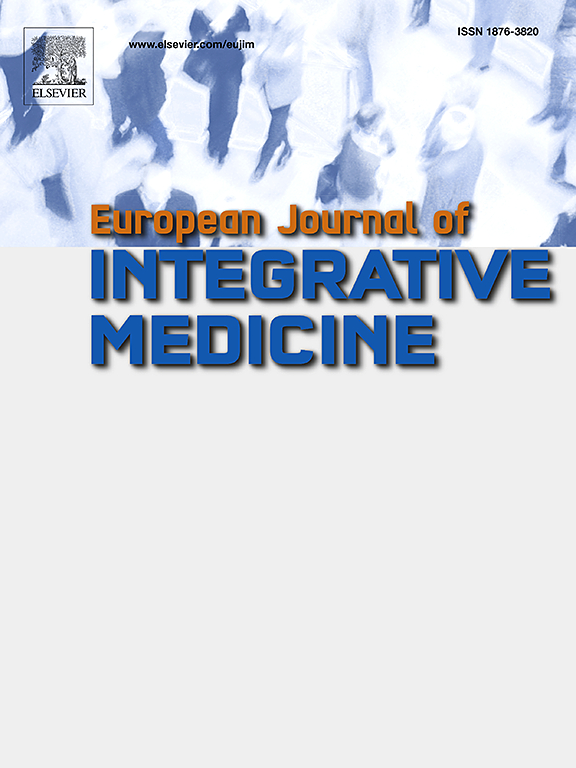探讨音乐干预和雷马唑仑对老年脊髓麻醉下经尿道前列腺切除术患者的镇静作用:一项随机对照临床试验
IF 1.7
4区 医学
Q3 INTEGRATIVE & COMPLEMENTARY MEDICINE
引用次数: 0
摘要
在临床实践中,药物和非药物干预被广泛用于术中镇静。然而,镇静的程度和副作用在两种方式之间有所不同。本研究旨在探讨音乐干预和雷马唑仑对脊柱麻醉下老年经尿道前列腺切除术(TURP)患者的镇静作用。方法前瞻性纳入60-80岁脊柱麻醉下行TURP的患者,随机分为无音乐组(A组)、音乐干预组(B组)、雷马唑仑组(C组)和雷马唑仑联合音乐干预组(D组)。采用双谱指数(BIS)评估主要结局。次要结局包括血压、心率(HR)、脉搏血氧饱和度(SpO2)、认知功能、不良事件发生率(包括身体运动和咳嗽)、呼吸抑制以及外科医生和患者满意度。结果本研究将120例患者随机分为4组,其中117例患者最终纳入分析。在特定时间点,B组[T7: TURP开始后20分钟,T11: TURP开始后60分钟,T14:离开手术室],C组(T3-14:立即换取石位离开手术室),D组(T3-14)的BIS值低于A组(P <;0.05)。与A组比较,C组和D组干预后血压和SpO2均显著降低(P <;0.05)。尽管C组和D组的不良事件发生率(包括身体运动和咳嗽)高于A组(P <;0.05),两组呼吸抑制发生率差异无统计学意义。值得注意的是,与A组相比,C组的外科医生满意度较低(P <;0.05)。结论雷马唑仑可诱导深度镇静,而音乐干预仅能起到轻微的镇静作用。然而,雷马唑仑也增加了身体运动和咳嗽的发生率,这可能会降低外科医生的满意度。临床试验注册chictr2300071284本文章由计算机程序翻译,如有差异,请以英文原文为准。
Exploring the sedation effect of music intervention and remimazolam in elderly patients undergoing transurethral prostate resection under spinal anesthesia: A randomized controlled clinical trial
Introduction
Pharmacological and non-pharmacological interventions are widely utilized in clinical practice for intraoperative sedation. However, the degree of sedation and side effects vary between the two modalities. This study aimed to explore the sedation effect of music intervention and remimazolam in elderly patients undergoing transurethral prostate resection (TURP) under spinal anesthesia.
Methods
Patients aged 60–80 years, scheduled for TURP under spinal anesthesia, were prospectively enrolled in this study and randomly assigned to no music group (Group A), music intervention group (Group B), remimazolam group (Group C), and remimazolam-combined-music intervention group (Group D). The primary outcome was assessed using the bispectral index (BIS). Secondary outcomes included blood pressure, heart rate (HR), pulse oxygen saturation (SpO2), cognitive function, the incidence of adverse events including body movement and coughing, and respiratory depression, as well as surgeon and patient satisfaction.
Results
The study randomly assigned 120 patients to four groups, with 117 patients ultimately included in the analysis. At specific time points, BIS values for Groups B [T7: 20 min after the start of TURP, T11: 60 min after the start of TURP and T14: leaving the operating room(OR)], C (T3–14: immediately after changing to lithotomy position to leaving the OR), and D (T3–14) were lower than those for Group A (P < 0.05). Compared to Group A, significant decreases in blood pressure and SpO2 were observed after intervention in Groups C and D, respectively (P < 0.05). Although the incidence of adverse events, including body movement and coughing, was higher in Groups C and D compared to Group A (P < 0.05), there was no significant difference in the incidence of respiratory depression. Significantly, surgeons reported lower satisfaction in Group C compared to Group A (P < 0.05).
Conclusions
While remimazolam induced deeper sedation, music intervention offered only a slight sedative effect. However, remimazolam also increased the incidence of body movement and coughing, which potentially reduced surgeon satisfaction.
Clinical trial registration
ChiCTR2300071284
求助全文
通过发布文献求助,成功后即可免费获取论文全文。
去求助
来源期刊

European Journal of Integrative Medicine
INTEGRATIVE & COMPLEMENTARY MEDICINE-
CiteScore
4.70
自引率
4.00%
发文量
102
审稿时长
33 days
期刊介绍:
The European Journal of Integrative Medicine (EuJIM) considers manuscripts from a wide range of complementary and integrative health care disciplines, with a particular focus on whole systems approaches, public health, self management and traditional medical systems. The journal strives to connect conventional medicine and evidence based complementary medicine. We encourage submissions reporting research with relevance for integrative clinical practice and interprofessional education.
EuJIM aims to be of interest to both conventional and integrative audiences, including healthcare practitioners, researchers, health care organisations, educationalists, and all those who seek objective and critical information on integrative medicine. To achieve this aim EuJIM provides an innovative international and interdisciplinary platform linking researchers and clinicians.
The journal focuses primarily on original research articles including systematic reviews, randomized controlled trials, other clinical studies, qualitative, observational and epidemiological studies. In addition we welcome short reviews, opinion articles and contributions relating to health services and policy, health economics and psychology.
 求助内容:
求助内容: 应助结果提醒方式:
应助结果提醒方式:


